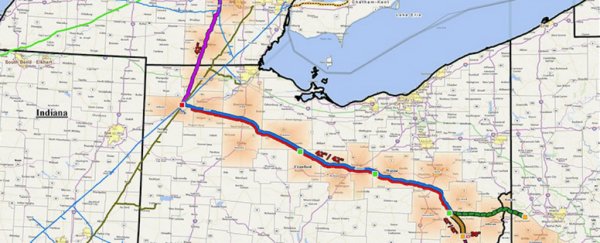Environmentalists say their "worst fears" have been confirmed, with the company behind the controversial Dakota Access Pipeline getting caught producing two major spills in its latest project, just one month after construction started.
The Rover Pipeline will ultimately carry natural gas across Pennsylvania, West Virginia, Ohio, Michigan, and Canada, crossing three major rivers in its path – but these latest incidents have caused millions of gallons of drilling fluids to flow into Ohio's wetlands.
News of the leak came out this week thanks to regulatory filings obtained by the Ohio chapter of environmental group, the Sierra Club.
In the documents, Energy Transfer Partners – the company behind the Rover Pipeline and the Dakota Access Pipeline – confirmed receiving notice of these "inadvertent" environmental violations.
According to the paperwork, on 13 April 2017, 7.6 million litres (2 million gallons) of drilling fluids were detected spilling into a wetland next to the Tuscarawas River in Stark County by the Ohio Environmental Protection Agency.
The drilling fluids covered an estimated 46,000 square metres (500,000 square foot) area of the wetlands and had "impacted water quality", according to the report.
On 14 April 2017, another 190,000 litres (50,000 gallons) of drilling fluids were detecting, spilling into a wetland in Richland County in the Mifflin Township.
Drilling fluids themselves aren't necessarily toxic or dangerous - you can think of them like a type of mud-based lubricant used to assist in the drilling of boreholes.
In this case, the fluid contained a type of clay known as bentonite, as well as mud and cuttings from the hole.
Those ingredients aren't in themselves dangerous in small doses, but what's concerning is that when they're released on waterways and wetlands in large quantities, they can affect water quality and the fragile balance of local ecosystems.
Spokesperson Alexis Daniel told Bloomberg that the spills wouldn't change the timeline of the US $4.2 billion pipeline, which is scheduled to be completed November 2017.
"Once the incidents were noted, we immediately began containment and mitigation and will continue until the issues are completely resolved," she said.
Once it's completed, the Rover Pipeline will cross some particularly important waterways in its 1,147-km (713-mile) length - including the Maumee, Sandusky, and Portage rivers, all of which feed into Lake Erie.
The US Federal Energy Regulatory Commission approved the Rover Pipeline's construction in February, and when it's finished, it will transport an estimated 92 billion litres (3.25 billion cubic feet) of natural gas from the US's eastern shale to the market each day.
But the Ohio Sierra Club says these early spills are evidence that Energy Transfer Partners aren't properly equipped to construct the pipeline without further environmental damage, and are protesting the continuation of the project.
"Construction just began just a few weeks ago, yet Energy Transfer has already spilled more than 2 million gallons of drilling fluids in two separate disasters, confirming our worst fears about this dangerous pipeline before it has even gone into operation," director of the Ohio Sierra Club, Jen Miller, told Eco Watch.
"We've always said that it's never a question of whether a pipeline accident will occur, but rather a question of when. These disasters prove that the fossil fuel industry is unable to even put a pipeline into use before it spills dangerous chemicals into our precious waterways and recreation areas."
"Construction on the Rover Pipeline must be stopped immediately, as an investigation into Energy Transfer's total failure to adequately protect our wetlands and communities is conducted," she added.
To be fair, pipelines haven't had the best environmental track record lately.
In December last year, as the Standing Rock protests continued over the Dakota Access Pipeline, a nearby pipeline spilled 176,000 gallons of oil into a creek just 2.5 hours away.
Worse, no one knows how long the pipeline was leaking before a local property owner noticed the spill.
That incident wasn't associated with Energy Transfer Partners, but it's just another sign that companies need to do a better job of monitoring and regulating these pipelines if they're going to conitnue to build them.
Let's hope the affected Ohio waterways can be cleaned up quickly, and that these notices from the Environmental Protection Agency are enough to keep Energy Transfer Partners vigilant throughout the rest of construction.
